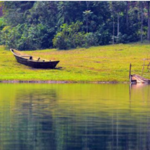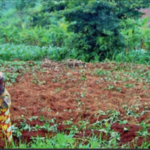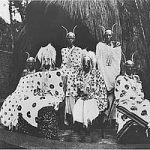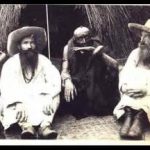Bananas: plantain and sweet bananas
In Gisaka, the banana is queen. It tops the list in economic importance and undoubtedly is an essential ingredient in the social life of the Hill; not only is the plantain eaten, but it is the principal source of native beer. (The author here follows the general custom of calling it a beer, but it is more precisely a wine.) The generic term for fermented drinks is inzoga; the generic name for banana beer is urwagwa,but the numerous varieties eachhave their own name.Beer is drunk in vast quantities by young and old and plays a very important role in the relationships between people within the social structure.
The first economic activity undertaken by any Munyarwanda settling in a new area is to plant a banana plantation. Then, he builds a house, while at the same time breaking ground for his fields and planting his seasonal crops. Generally speaking, the Munyaremera wants his house to be located in the midst of his fields, and preferably surrounded by his banana plantation.
The importance of the plantain and bananas in general, is illustrated by the fact that the peasants distinguish over twenty varieties, classifying them according to use, and according to the color and form of both the fruit and the trunk of the plant.
The banana plantation is truly the part of the peasants’ land-holdings of which they take the best care. Especially on the summit where the land has to be heavily fertilized to produce well, work is accomplished with great regularity; the weeds are hoed under and old banana plants and broken leaves are chopped down and left as fertilizer. The largest bunches of plantains are often propped up with long poles to keep thon from causing the plant’s trunk to break under their weight.
Plantains, like all bananas, have no seeds, so the Munyaremera makes a new plantation by transplanting suckers. (Suckers are also the means through which old plantations perpetuate themselves.) The heads of suckers over six feet tall are cut off and the rooted plants is dug out and transplanted in prepared holes about fifteen inches deep, in which green fertilizer has been placed. This is done in September at the beginning of the rainy season.
The new plants, take from one to three years to produce fruits,depending on the type of soil. Each plant produces one bunch only, after which it is replaced by its own offshoots.
Plantains are a year-round crop, but they are at peak production at the beginning of the dry season (July-August), and in low production in March and April, when the heaviest rains fall.
The bunches are gathered shortly before they reach maturity. They are artificially ripened over a low fire, or by being buried near as cask of fermenting banana juice. Sometimes they are completely covered with earth, with only an air vent left at the base. A fire is built in front of this vent to help ripen the bananas. The process of ripening lasts no more than two or three days. If they were left to ripen on, the stalk birds and monkeys would eat them.
Either the ripe plantains are cooked in water, usually with beans, or they are made into beer. To make the latter, a dugout wooden container (umuvure), approximately five or six feet long and a foot and a half wide, is covered with a latticework of twigs strong enough to support the weight of a man. This latticework is designed to strain the juice, which is extracted by placing the fruit upon the grid and stamping it with the feet. The pulp is mixed with a thin, but resistant grass to prevent it from falling through the grating into the liquid. Water is added to the extracted juice, plus a mixture of degerminated sorghum seeds and ashes, which apparently are essential for fermentation. The umuvure is then placed in a hole in the ground and is covered over with pieces of banana trunk, banana leaves, and, finally, earth. The preparation is left to ferment for three days, after which it is ready to drink. It is usually best when drunk at that time, as it might turn sour if kept too long.
https://uk.amateka.net/bananas-plantain-and-sweet-bananas/https://uk.amateka.net/wp-content/uploads/2021/03/banana.jpghttps://uk.amateka.net/wp-content/uploads/2021/03/banana-150x150.jpgAgricultureModel CitizenshipIn Gisaka, the banana is queen. It tops the list in economic importance and undoubtedly is an essential ingredient in the social life of the Hill; not only is the plantain eaten, but it is the principal source of native beer. (The author here follows the general custom of...BarataBarata rpierre@ikaze.netAdministratorAMATEKA | HISTORY OF RWANDA




